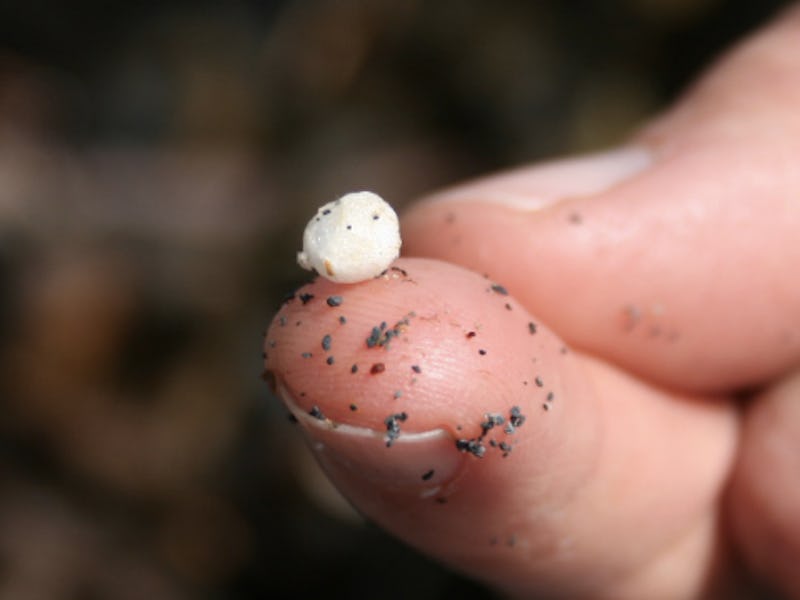This tiny Trojan Horse could be an environmental disaster
A new study reveals how microplastics disguise themselves to infiltrate the body.

You can’t see them, but microplastics are everywhere. These tiny plastic pieces may be less than half a centimeter in length, but they are also the most ubiquitous form of plastic pollution in the world. Microplastics have been found near the summit of Mount Everest, in the snowfall of the Arctic, and even in human excrement.
Study after study shows microplastics are pretty much inescapable on Earth, but the damage they wreak on the environment — and by extension, us — has remained obscure. Now, a new study reveals exactly how microplastics infiltrate the cells of living animals: they take their time.
What's new — The study, published Wednesday in the journal Science Advances, shows how a piece of microplastic — say, a sesame seed-sized piece of a styrofoam cup — becomes increasingly efficient at becoming attached to and internalized by the body's cells within 2 to 4 weeks of being in an ocean or freshwater environment. Older particles are internalized "approximately 10 times more often" than are pristine particles, the study finds.
In other words, the longer microplastic beads were in water, the more biomolecules they attached to.
One of the anxieties around microplastics is that they can end up in the fish we eat.
What they did — Researchers from the University of Bayreuth in Germany took freshwater from an artificial pond and saltwater from a small aquarium to conduct the study. They used water devoid of any microorganisms or other particles as a control.
To see how microplastics changed after they make it into the three kinds of water, the scientists put samples of tiny particles just 3 micrometers in length into water and analyzed them at different intervals of time — after 2 hours, 2 weeks, and 4 weeks.
After the 2-week and 4-week intervals, microplastics in both salt and freshwater showed significant changes to their surface. In the case of the freshwater-treated particles, there were obvious differences in the surface morphology of the beads, while in the saltwater-treated particles there was evidence of salts clustering on the plastics' surface. The scientists dub these changes "ecological coronas, or eco-coronas." Eco-coronas form when a layer of biomolecules coat the artificial microplastics, essentially cloaking these particles in a shroud of natural material.
“Once biomolecules adsorb onto microplastic particle surfaces, they may function as a chemical stimulus for the attachment and internalization of those particles into cells,” the authors write.
Why it matters — The implications of these changes became obvious when the researchers exposed cultured mouse cells to the treated microplastics.
Images from the study's scanning electron microscopy. The left arrow shows microplastic particles embedded in larger salt crystals, the right arrow magnifies circular layers found on the microplastics.
The biomolecular coating “enhances the cellular internalization of microplastic” particles into the mouse cells, the authors say. The eco-corona “is an “important factor” in inducing that internalization, a process also known as endocytosis.
The longer the microplastics are in water, the more biomolecules they pick up. And the more biomolecules the microplastics get, the better they are at internalizing themselves in mouse cells. Essentially, eco-coronas act like a Trojan horse, convincing cells the microplastics should be allowed inside.
If this occurs in mouse cells, then it is possible the same process ferries microplastics inside other animals' cells — including human cells.
The Inverse analysis — The jury is out on whether microplastics cause direct damage to human health.
A 2019 World Health Organisation study found “insufficient information to draw firm conclusions” on the toxicity of microplastics. More recently, a February 2020 overview of the current scientific evidence on the dangers of microplastics concluded there is a “considerable lack of knowledge on the major additives of concern that are used in the plastic industry, on their fate once microplastics dispose into the environment, and on their consequent effects on human health.”
But scientists are concerned. In September 2020, one group of scientists released a paper directly comparing the Covid-19 pandemic to microplastics, stating the world “does not want to be caught off guard by another” environmental catastrophe. This new study shows how urgently further research into microplastics and how they may infiltrate our bodies is needed.
Abstract: Microplastic particles ubiquitously found in the environment are ingested by a huge variety of organisms. Subsequently, microplastic particles can translocate from the gastrointestinal tract into the tissues likely by cellular internalization. The reason for cellular internalization is unknown, since this has only been shown for specifically surface-functionalized particles. We show that environmentally exposed microplastic particles were internalized significantly more often than pristine microplastic particles into macrophages. We identified biomolecules forming an eco-corona on the surface of microplastic particles, suggesting that environmental exposure promotes the cellular internalization of microplastics. Our findings further indicate that cellular internalization is a key route by which microplastic particles translocate into tissues, where they may cause toxicological effects that have implications for the environment and human health
This article was originally published on